Pangolin — a legend of Soviet "self-building"
 Bashny.Net
Bashny.Net
One of the most famous examples of the Soviet movement "SamAvto" is the Pangolin, a unique homemade car, the local response to the famous Lamborghini Countach and the DeLorean DMC-12, assembled in Ukhta electrician Alexander by Caliginem in 1980.
That's how it was and what ended ...

The author posing with his creation
So, built in 1979, six-wheeled all-terrain vehicle "Ukhta", an engineer by education, an electrician in the Palace of children's creativity of the city of Ukhta in the profession and part-time head of the circle of technical creativity of Alexander Kulygin, a year later, decided to build the car, how he saw it. Possibly brilliant idea, really, floating in the air, and maybe the author deliberately went for it, but the design of the car, later recognized by many, was the style of the famous and very fashionable at the time of the supercar Lamborghini Countach (Lamborghini Countach) from the Atelier of Bertone (Bertone).
An effective but relatively simple with straight planes, block design, which decided to use the author, allowed to applied to the wall of the bodywork of the car on a plywood disc (the master model). This work Alexander has done in Moscow, and the final Assembly of the car he produced in their native city of Ukhta, with the help of his students pioneers. The word is to say that immediately after completion of the work, all body of the matrix were destroyed. What caused it is unknown. Perhaps because the author wanted to preserve the uniqueness of his creation.
The car decided to name "Pangolin" for the similarity with beast battleship-the Pangolin. The body was built from fiberglass panels, hung on spatial tubular frame, this design had a self-made car, but otherwise it was very original.

A. Kulygin driving Pangolins
Judge for yourself, instead of the usual hinged doors, the car was climbing two hydraulic cylinders cap. Looking ahead, it is worth saying that once the author has had to bail out of the car, when the hydraulic pressure went, because a cap was weighty enough. He combines side door, the front half of the roof and windshield that was made from the "properties)" from the minibus RAF. Subsequently, some "homebrew" used a similar, spectacular, but very impractical design in their cars. Windshield "Pangolins" have provided a "breaking" wiper. Alexander brought his two "janitors" from "Ikarus". The kinematics of the device was so good that the windshield was cleaned on 95%. This was considered to be the "know-how" of the designer.
A year later, about Pangolin, I learned the whole of the Soviet Union — Kulygin brought their offspring to Moscow (by rail, as the Soviet route for the squat of the car just didn't fit), and soon the machine together with its author got on TV and the pages of periodicals. Inspired, first and foremost, a stunning Lamborghini Countach (after which the global automotive Vogue "awkward" squat and sports cars), Pangolin has shocked the imagination of the Soviet audience.
Of course, its design did not differ as verified lines as the work of genius of the Italians from the Studio Bertone, but the Soviet engineer managed to come up with several elegant and original solutions: rising on hydraulic driven hood instead of the doors, 4 lights in a single unit, "traveling" from the center of the hood, a periscope (!) instead of conventional rear view mirrors. The lightest body of fiberglass "stood up" on a homemade aluminum alloy wheels, shod in low profile tires (to get it in Soviet times, it was incredibly difficult).
Internal filling Pangolins consisted solely of parts and components of conventional serial WAS s. This is a classic engine in the front, which turned rests against the driver and placed directly under the dashboard — the body Pangolins was proportioned centralnorthern supercar, which under the hood just did not provide room for the engine.
The rearview mirror was located under the small fairing on the roof of the car. In order to use them in the roof above the driver's seat was mounted window. By the way, a car seat was made in the form of aircraft seats with very high backs. They say that they were very comfortable to sit. To improve visibility ago, Alexander has mounted a rear view camera, and this at a time when the Soviet Union cars coming down the Assembly line, had not yet completed the right side mirrors. Powerfully illuminate the road in the dark have been called four lights that were put forward in the center of the hood electrically. It was very unusual and spectacular, and also improved the aerodynamics of the car when headlights are not needed.
Rear and side glass of the car was also with a twist. Since the rear window of the car was located almost vertically, it is inevitably thrown would go mud fog. So above it was a small spoiler, which cuts off the flow of air in the desired direction, and the glass remained almost clean. The side Windows consisted of several parts, a small part was open. It was later made a small window for off cigarette ash designer smoked.
Homemade car Pangolin standing on self-made Alexander the discs of aluminium alloy, clad in low-profile tires, which he found from friends this year. Both at the time was a great novelty in the Soviet Union. In the rest of the suspension as the engine volume of 1200 cubic centimeters and a capacity of 62 horsepower, was standard, from the VAZ "classics", though initially the car was conceived with a boxer (flat) engine. The muffler was completely improvised, under a Luggage compartment it is bifurcated and ends under the rear bumper and the two striking, symmetrical nozzles of rectangular shape, matching the design of the car. Front of the rear axle were installed two fuel tanks, right and left, each with a separate neck.

The layout of the car has turned out as the real sports cars – mid-engined. Because of the rather sloping "nose "penny" the engine was not enough space in the front compartment, and it had to be moved far back as possible behind the front axle, into the database, which resulted in several original design solutions.
For example, due to the fact that the engine was located directly beneath the torpedo panel to service the motor it was made for reclining Gidropark, and with her lean and steering column. For this purpose, the steering shaft was installed additional cardanic. And for speakers the size of the engine cover cylinder head, air filter housing and of the distributor in the center panel was done the rise. The brake booster was deployed to 180 degrees, this also demanded linkage. The panel was quite serious, acoustic and thermal insulation. Under the hood, where a conventional car the engine was located, was only mounted radiators and the battery.
Although the standard toppings from the "classics", lightweight fiberglass body and excellent aerodynamics "Pangolins" have allowed it to accelerate to 180 km/h Unattainable speed for the usual "the Zhiguli".
80 years is the Golden time for "Pangolins". Together with his Creator, she participated in a number of Union rallies and even visited the international automobile exhibition "EXPO-85" ("EXPO-85") in Plovdiv, Bulgaria. However to obtain state license plates and permissions to travel abroad on a machine I had to install two additional lights, side rearview mirrors and standard wheels, which the author has decorated the futuristic, solid caps. Then, the body was repainted in dark green color.
In the early ' 90s, the car lost its original "breaking" the janitor". For some unknown reason was replaced conventional wiper tailgate VAZ eighth model.
In the mid-90s, the vehicle had to redo it after the accident. An inattentive truck driver, renting reversing, much got all twisted that way the middle part of the lifting of the cap "Pangolins". As the body of the matrix were destroyed, restoring it could not be. It was decided to remove the roof. As it turned out, the roof has performed the role of the power element and after it was removed, the body began to "sink" in the middle. To fix it, under the bottom of warily reinforcing beams. After the repair the car was painted in the colors of "red Ferrari", which has been preserved to this day.
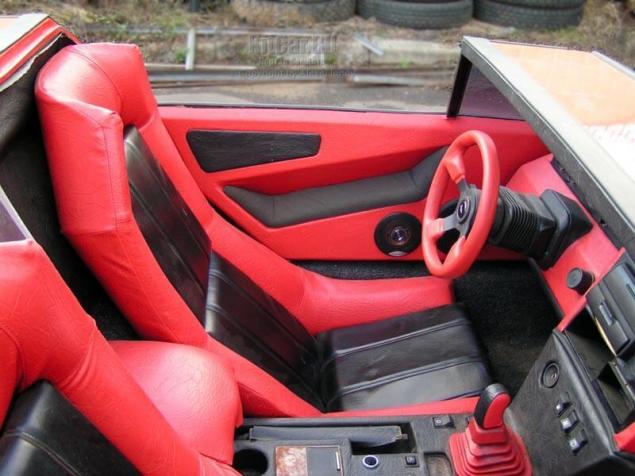
Around the same time in the trunk of the car there was a CD-changer and subwoofer, and on the Windows – blanking tinted and pseudoparticle stickers. Automotive fashion has left its mark on, even then, the legend of the "SamAvto".


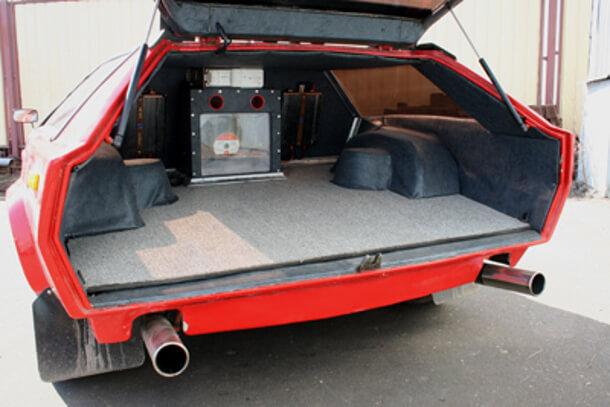
The popularity of "Pangolins", of course, is reflected on the fate of its Creator. In the perestroika period he had received proposals from the design office of VAZ and AZLK. Alexander decided to stay in Moscow. Since the late ' 80s to mid-90s he works at the AZLK, but too original opinion of the engineer in the design of the car was not accepted by the ossified consciousness of post-Soviet designers, and his designs remained prototypes.

The cover of the book "I am building the car" (on homemade machines created by craftsmen from all over the Soviet Union, the number of which was calculated on the wave of popularity of the movement "SamAvto" in the tens) were decorated with pictures by A. kulygina driving Pangolins
After this, Alexander emigrated to the United States, the city of new York, where he opened a small office in the development, manufacturing and selling kit-cars – kits, which themselves can pick up the car.
On 13 December 2004, about 9: 30am, on the way to work on his Yamaha, Alexander Kulygin was tragically killed in an accident caused by a driver who made a manoeuvre without looking in the rear view mirror.
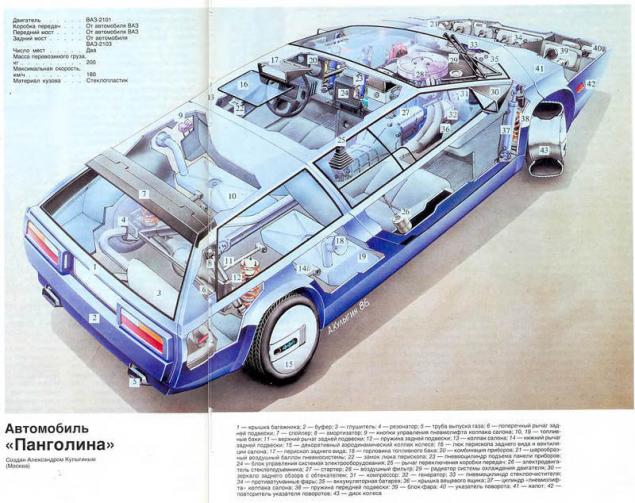
Scheme Pangolins from the book "I am building the car"
It was shown as part of the application for transfer can be - "Auction". A curious detail: when the transfer of "Pangolin" was put on sale (by the way, for a lot of, in those days, 38000 rubles), leading Vladimir Solovyov somehow said that the car has an engine from LADA 1600. Perhaps there was a replacement engine, but maybe it was a simple mistake,
As for the legendary homemade, emerging from its Creator, the traces of "Pangolins" was lost at the end of the past decade. Not so long ago purchased by some businessman in a private property the car can be viewed at the Museum "Autoreview", but now it's closed indefinitely and the fate of many of its exhibits, unfortunately, unknown. published
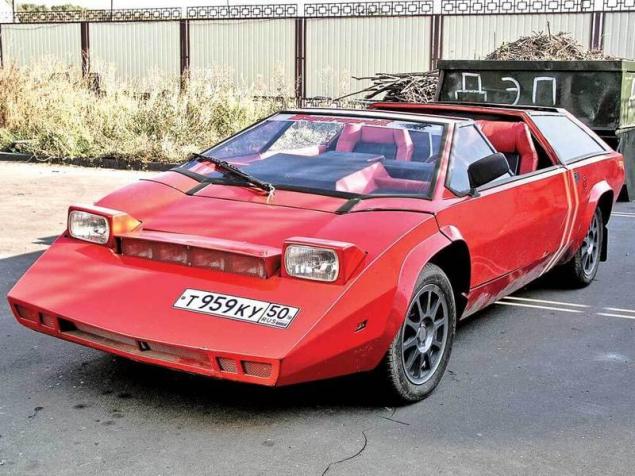
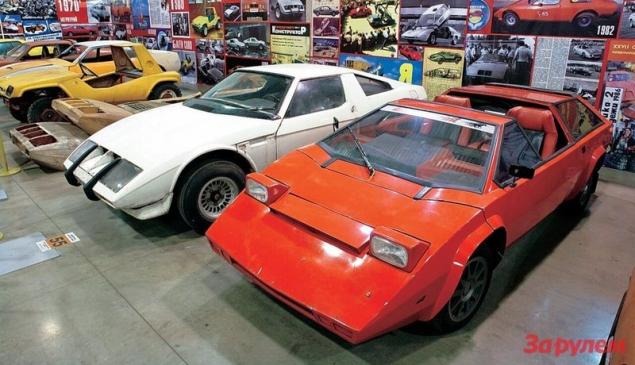
P. S. And remember, only by changing their consumption — together we change the world! © Join us at Facebook , Vkontakte, Odnoklassniki
Source: masterok.livejournal.com/2509965.html
That's how it was and what ended ...

The author posing with his creation
So, built in 1979, six-wheeled all-terrain vehicle "Ukhta", an engineer by education, an electrician in the Palace of children's creativity of the city of Ukhta in the profession and part-time head of the circle of technical creativity of Alexander Kulygin, a year later, decided to build the car, how he saw it. Possibly brilliant idea, really, floating in the air, and maybe the author deliberately went for it, but the design of the car, later recognized by many, was the style of the famous and very fashionable at the time of the supercar Lamborghini Countach (Lamborghini Countach) from the Atelier of Bertone (Bertone).
An effective but relatively simple with straight planes, block design, which decided to use the author, allowed to applied to the wall of the bodywork of the car on a plywood disc (the master model). This work Alexander has done in Moscow, and the final Assembly of the car he produced in their native city of Ukhta, with the help of his students pioneers. The word is to say that immediately after completion of the work, all body of the matrix were destroyed. What caused it is unknown. Perhaps because the author wanted to preserve the uniqueness of his creation.
The car decided to name "Pangolin" for the similarity with beast battleship-the Pangolin. The body was built from fiberglass panels, hung on spatial tubular frame, this design had a self-made car, but otherwise it was very original.

A. Kulygin driving Pangolins
Judge for yourself, instead of the usual hinged doors, the car was climbing two hydraulic cylinders cap. Looking ahead, it is worth saying that once the author has had to bail out of the car, when the hydraulic pressure went, because a cap was weighty enough. He combines side door, the front half of the roof and windshield that was made from the "properties)" from the minibus RAF. Subsequently, some "homebrew" used a similar, spectacular, but very impractical design in their cars. Windshield "Pangolins" have provided a "breaking" wiper. Alexander brought his two "janitors" from "Ikarus". The kinematics of the device was so good that the windshield was cleaned on 95%. This was considered to be the "know-how" of the designer.
A year later, about Pangolin, I learned the whole of the Soviet Union — Kulygin brought their offspring to Moscow (by rail, as the Soviet route for the squat of the car just didn't fit), and soon the machine together with its author got on TV and the pages of periodicals. Inspired, first and foremost, a stunning Lamborghini Countach (after which the global automotive Vogue "awkward" squat and sports cars), Pangolin has shocked the imagination of the Soviet audience.
Of course, its design did not differ as verified lines as the work of genius of the Italians from the Studio Bertone, but the Soviet engineer managed to come up with several elegant and original solutions: rising on hydraulic driven hood instead of the doors, 4 lights in a single unit, "traveling" from the center of the hood, a periscope (!) instead of conventional rear view mirrors. The lightest body of fiberglass "stood up" on a homemade aluminum alloy wheels, shod in low profile tires (to get it in Soviet times, it was incredibly difficult).
Internal filling Pangolins consisted solely of parts and components of conventional serial WAS s. This is a classic engine in the front, which turned rests against the driver and placed directly under the dashboard — the body Pangolins was proportioned centralnorthern supercar, which under the hood just did not provide room for the engine.
The rearview mirror was located under the small fairing on the roof of the car. In order to use them in the roof above the driver's seat was mounted window. By the way, a car seat was made in the form of aircraft seats with very high backs. They say that they were very comfortable to sit. To improve visibility ago, Alexander has mounted a rear view camera, and this at a time when the Soviet Union cars coming down the Assembly line, had not yet completed the right side mirrors. Powerfully illuminate the road in the dark have been called four lights that were put forward in the center of the hood electrically. It was very unusual and spectacular, and also improved the aerodynamics of the car when headlights are not needed.
Rear and side glass of the car was also with a twist. Since the rear window of the car was located almost vertically, it is inevitably thrown would go mud fog. So above it was a small spoiler, which cuts off the flow of air in the desired direction, and the glass remained almost clean. The side Windows consisted of several parts, a small part was open. It was later made a small window for off cigarette ash designer smoked.
Homemade car Pangolin standing on self-made Alexander the discs of aluminium alloy, clad in low-profile tires, which he found from friends this year. Both at the time was a great novelty in the Soviet Union. In the rest of the suspension as the engine volume of 1200 cubic centimeters and a capacity of 62 horsepower, was standard, from the VAZ "classics", though initially the car was conceived with a boxer (flat) engine. The muffler was completely improvised, under a Luggage compartment it is bifurcated and ends under the rear bumper and the two striking, symmetrical nozzles of rectangular shape, matching the design of the car. Front of the rear axle were installed two fuel tanks, right and left, each with a separate neck.

The layout of the car has turned out as the real sports cars – mid-engined. Because of the rather sloping "nose "penny" the engine was not enough space in the front compartment, and it had to be moved far back as possible behind the front axle, into the database, which resulted in several original design solutions.
For example, due to the fact that the engine was located directly beneath the torpedo panel to service the motor it was made for reclining Gidropark, and with her lean and steering column. For this purpose, the steering shaft was installed additional cardanic. And for speakers the size of the engine cover cylinder head, air filter housing and of the distributor in the center panel was done the rise. The brake booster was deployed to 180 degrees, this also demanded linkage. The panel was quite serious, acoustic and thermal insulation. Under the hood, where a conventional car the engine was located, was only mounted radiators and the battery.
Although the standard toppings from the "classics", lightweight fiberglass body and excellent aerodynamics "Pangolins" have allowed it to accelerate to 180 km/h Unattainable speed for the usual "the Zhiguli".
80 years is the Golden time for "Pangolins". Together with his Creator, she participated in a number of Union rallies and even visited the international automobile exhibition "EXPO-85" ("EXPO-85") in Plovdiv, Bulgaria. However to obtain state license plates and permissions to travel abroad on a machine I had to install two additional lights, side rearview mirrors and standard wheels, which the author has decorated the futuristic, solid caps. Then, the body was repainted in dark green color.
In the early ' 90s, the car lost its original "breaking" the janitor". For some unknown reason was replaced conventional wiper tailgate VAZ eighth model.
In the mid-90s, the vehicle had to redo it after the accident. An inattentive truck driver, renting reversing, much got all twisted that way the middle part of the lifting of the cap "Pangolins". As the body of the matrix were destroyed, restoring it could not be. It was decided to remove the roof. As it turned out, the roof has performed the role of the power element and after it was removed, the body began to "sink" in the middle. To fix it, under the bottom of warily reinforcing beams. After the repair the car was painted in the colors of "red Ferrari", which has been preserved to this day.

Around the same time in the trunk of the car there was a CD-changer and subwoofer, and on the Windows – blanking tinted and pseudoparticle stickers. Automotive fashion has left its mark on, even then, the legend of the "SamAvto".



The popularity of "Pangolins", of course, is reflected on the fate of its Creator. In the perestroika period he had received proposals from the design office of VAZ and AZLK. Alexander decided to stay in Moscow. Since the late ' 80s to mid-90s he works at the AZLK, but too original opinion of the engineer in the design of the car was not accepted by the ossified consciousness of post-Soviet designers, and his designs remained prototypes.

The cover of the book "I am building the car" (on homemade machines created by craftsmen from all over the Soviet Union, the number of which was calculated on the wave of popularity of the movement "SamAvto" in the tens) were decorated with pictures by A. kulygina driving Pangolins
After this, Alexander emigrated to the United States, the city of new York, where he opened a small office in the development, manufacturing and selling kit-cars – kits, which themselves can pick up the car.
On 13 December 2004, about 9: 30am, on the way to work on his Yamaha, Alexander Kulygin was tragically killed in an accident caused by a driver who made a manoeuvre without looking in the rear view mirror.

Scheme Pangolins from the book "I am building the car"
It was shown as part of the application for transfer can be - "Auction". A curious detail: when the transfer of "Pangolin" was put on sale (by the way, for a lot of, in those days, 38000 rubles), leading Vladimir Solovyov somehow said that the car has an engine from LADA 1600. Perhaps there was a replacement engine, but maybe it was a simple mistake,
As for the legendary homemade, emerging from its Creator, the traces of "Pangolins" was lost at the end of the past decade. Not so long ago purchased by some businessman in a private property the car can be viewed at the Museum "Autoreview", but now it's closed indefinitely and the fate of many of its exhibits, unfortunately, unknown. published


P. S. And remember, only by changing their consumption — together we change the world! © Join us at Facebook , Vkontakte, Odnoklassniki
Source: masterok.livejournal.com/2509965.html
Tags
See also
The first Soviet SUV: The Unknown Story
Cars stars of the 20th century (12 pics + text)
The most unusual trolley USSR
Trolley enhanced comfort
On all-wheel drive for the Soviet motherland
The last car Trabant.
History AUDI (tion of text and photos)
Koenigsegg Regera — megabrid from Sweden
They were the first
Larisa Reisner and Nikolai Gumilev: Leri and Hafiz
















